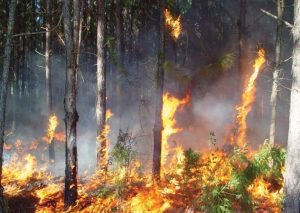
Walking through the forest, Japanese climbing fern (Lygodium japonicum) might catch your eye. The fronds are delicate and almost lacy in shape, winding their way along the stems of shrubs and trunks of trees. Like most vines, they rely on other plants or structures for support. The primary stem of a climbing fern, called a rachis, will wind around, grasping for an anchor and leading the plant skyward. Some vines have been observed at over 90’ long. Truly opportunistic, the plants can grow in full sun or shade, in deep forests, disturbed edges, and in upland or wetland soils.

While effective in its own self-preservation, Japanese climbing fern is less generous towards our native plant species. The vine will frequently overtake trees, blocking out light to the point that trees decline and die. Their coverage along the ground and along lower-growing shrubs can also stunt and prevent new tree seedlings from germinating.

While introduced nearly 100 years ago as an ornamental plant, the vine was not truly problematic until the late 1990’s. Twenty years ago, it was relatively rare to see the vines locally, but they’ve increased in population. As the species’ prevalence expanded to southern pine forests, it was inadvertently distributed through the pine straw trade. Typically, a homeowner infestation of Japanese climbing fern will start with a small piece of fern frond wrapped up in a bale of pine straw purchased commercially. When the pine straw is spread around the yard as mulch, microscopic spores from the ferns blow around in the wind, get picked up by people or animals, then drop into the ground, taking root.

If you do see Japanese climbing fern in your yard or a bale of straw, it is easy enough to remove and uproot small plants. However, like most invasive species, once unrestrained growth begins, management is nearly impossible. In forested areas, treatment with glyphosate blended with metsulfuron methyl can cut back the population. However, this must be repeated multiple times to manage the vine. Killing back with fire is ineffective with Japanese climbing fern, as their rhizomes grow back quickly post-fire. The vine also serves as a “ladder fuel” that takes flames up the trunks of large trees, causing damage to the crown.
 6
6
